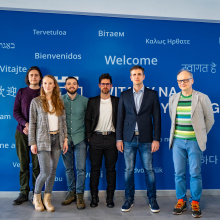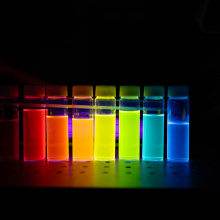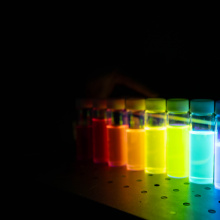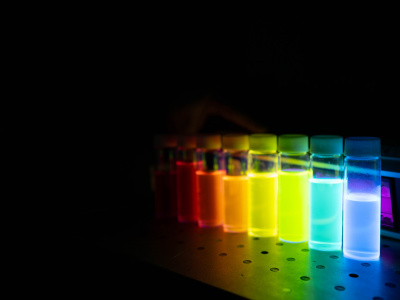
Researchers from the University of Gdańsk have developed new efficient and stable emitters for use in so-called fourth-generation OLEDs. The article, in which they describe the entire process from design to testing of the new devices, was published in the prestigious ASC journal ‘Applied Materials & Interfaces’ with an impact factor of 9.6 and an MNiSW score of 200 points. OLED diode technology is widely used in modern televisions; however, it currently utilises toxic heavy metals. Research by scientists has brought us closer to creating fully organic emitters with commercial potential.
'Currently, much of the industry's effort is focused on improving 3rd and 4th generation emitters,' explains one of the publication's co-authors, dr Michał Mońka. ‘Unfortunately, a major implementation roadblock in this group of materials is their low stability, which causes pixel burn-in in OLED arrays and significantly shortens their lifespan. To talk about commercialisation, it is necessary to develop a way to increase their durability.’
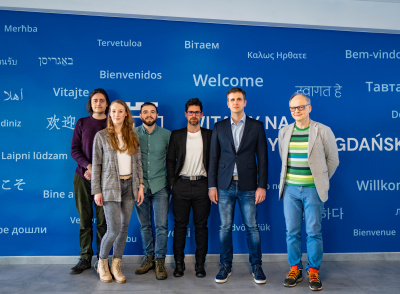
The results show promise for increasing the lifetime of OLEDs completely free of heavy metals. The absence of toxic chemicals would mean that the new emitters would be fully organic. In future, they could be applied to surfaces using 3D printing technology.’
The authors of the publication from the University of Gdańsk are employees of the Faculty of Mathematics, Physics and Informatics - dr Michał Mońka, dr Illia Serdiuk, dr Daria Grzywacz, dr hab. Aleksander Kubicki, prof. UG, and prof. dr hab. Piotr Bojarski - and PhD students of WMFiI and the Faculty of Chemistry of UG, mgr Vladyslav Ievtukhov and mgr Karol Kozakiewicz.
In the publication, the researchers describe how, by combining the phenomena of thermally activated delayed fluorescence (TADF), the heavy atom effect, and resonant fluorescence energy transfer (FRET), new efficient and stable 'hyperfluorescent' systems emitting light in the red spectral range have been developed.
Thanks to collaboration with the Technical University of Lodz and the Stanisław Staszic University of Science and Technology in Krakow, it was possible to carry out application tests in which OLED devices based on the new circuits showed a more than twofold increase in stability relative to performance, which is a significant advance in solving the current problem of OLED technology. The authors of the publication are seven scientists from UG and three scientists from other universities: Gdańsk University of Technology, AGH University of Science and Technology in Kraków, and Łódź University of Technology.
Dr Michał Mońka talks about new emitters and the future of OLED technology
Marcel Jakubowski: - New generations of OLEDs are better than previous ones in many respects. Which features in your work on the new emitters have you managed to improve, enhance or accelerate?
Dr Michał Mońka: - OLED (Organic Light-Emitting Diode) displays consist of a number of very thin (several nanometres thick) layers with specific functions. The key component in their structure is the emission layer, where the conversion of electrical energy into light energy takes place. Materials (chemical compounds) that are capable of this are called emitters. The properties of these materials at the molecular level determine the macroscopic characteristics of the displays, such as efficiency, stability, or colour.
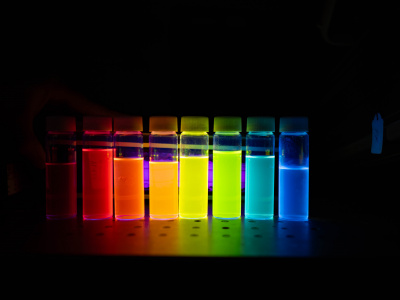
To date, four generations of OLEDs have been developed, which differ in the type of emitters used. The first generation of OLEDs were fluorescent emitters, whose serious limitation was their low efficiency. The second generation includes emitters containing heavy metals (mainly iridium and platinum). Their efficiencies are much higher, but their use carries very high production costs and complicated disposal procedures.
Currently, much of the industry's effort is focused on improving 3rd and 4th generation emitters. These are fully organic (no toxic heavy metals) emitters with efficiencies of more than 40% today. Unfortunately, a major implementation roadblock in this group of materials is their low stability, which causes pixel burn-in in OLED arrays and significantly shortens their lifespan. To talk about commercialisation, it is necessary to develop a way to increase their durability.
In a recent article, we described the case of a red emitter in which it was possible to more than double the stability while not sacrificing high efficiency and the desired level of colour purity. By properly designing the chemical structure, we have retained the fully organic nature of the material, so there is no need to worry about high synthesis costs and problematic disposal methods. In addition, we have shown that such a material can be fed into devices from solution, namely targeting the Ink-Jet Printing (IJP) method. This will mean a more economical use of resources in the manufacturing process of displays and the possibility of coating various, not necessarily flat, surfaces (e.g. clothing) with emissive materials.
- What are the biggest problems with OLED technology at present?
- For the reasons mentioned earlier, at present, only first- and second-generation OLEDs are commercially relevant. Although the word 'organic' is hidden in the acronym OLED, the second generation of emitters, after all, contain heavy metal elements and therefore disqualify them from certain applications.
To meet the demands made by the industry, we are working on making fully organic 3rd and 4th generation emitters more stable. In this respect, the biggest problem is with blue light emitters because, after the application of an electrical charge, the energy that a blue emitter 'has to take on' is greater than, for example, for a green emitter, and the likelihood of harmful side phenomena to the light emission is greater. Some of these phenomena involve changes in the chemical structure of the emitters and modification of their photophysical properties. As a consequence, the emitter may lose its function and become useless as an inactive molecule. The diversity of molecules and the complexity of the mechanisms that occur in the excited state mean that there is no one-size-fits-all method to increase the lifetime of emitters.
Turning to red emitters, it seems that the more we try to improve their stability, the lower the yield we get. We do not accept that we have to accept the stability vs. performance trade-off and so we are looking for new ways to solve this problem. Our recent article is an example of how such solutions exist.
- Given the popularity of OLEDs, for example in TVs, can we talk about the potential commercial application of your solutions in various devices?
- Of course, our long-term 'technological' goal is to develop fully organic, stable and efficient emitters that can be commercialised and implemented for widespread use in TVs, smartphones, etc. To date, we have designed several hundred new emitters for 3rd and 4th generation applications. We are trying to synthesise the most promising ones and verify their application potential in our laboratories using constructed experimental tools. The final stage is the actual OLED testing, which provides clear information on the suitability of the new emitters and the possible impact of the applied modifications. The tests are carried out in friendly specialised research centres in Poland, England and Korea, which have appropriate equipment dedicated to such tests.
Our best inventions are protected by patent rights, and it is intending to implement them that we actively seek partners in the business sector. Since 2023, we have also collaborated with Noctiluca (Toruń), a company involved in the mass production of OLED materials.
The research was funded under the LIDER XI (LIDER/47/0190/L-11/19/NCBR/2020, led by dr Illia Serdiuk) and Sonata 16 (UMO-2020/39/D/ST5/03094, led by dr Illia Serdiuk) grants.

